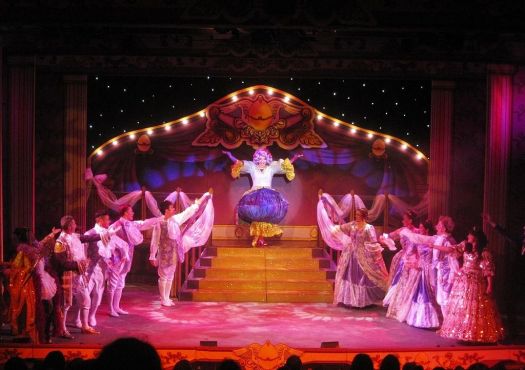Panto is paused? Oh no it isn’t: The impact of COVID-19 on traditional pantomimes
17 December 2020
Socially distanced or online, theatres are determined to carry on the Christmas tradition
By Dr Josh Edelman and Dr Michael Pinchbeck, Manchester School of Theatre
Act One: History (MP)
Pantomime dates back to Commedia Dell’Arte, a physical form of comedy popular in the 16th Century. It rolled on through the 17th and 18th century accumulating traits of music hall and cabaret, until it became the festive tradition it is today, and so important to our regional theatre industry.
As we approach Panto Day (December 18), this is thrown into stark focus. Recent research, pre-Covid, suggested that 40% of the average regional theatre’s audience attend the Christmas pantomime and it contributes about 30% of many theatre’s annual box office revenue; around £63m in total. Pause the panto, and you pause the income.
Only 25% of the audience attend more than once a year which suggests 75% of the audience are panto-regulars and only step foot in a theatre for the annual event.
It’s not just the show that makes money, it’s also the merchandise, the refreshments, the candy floss for children and maybe something stronger for the parents. Why do you think there are sometimes two intervals? Those neon toys that children wave in the air are not just for fun - they make a profit. Even programmes are sold to generate an income, not as souvenirs.
More than anything, it is a festive tradition, passed like the artificial Christmas tree or baubles in the attic, through families. My grandparents took me, and now my parents take my children etc. The traditions have stayed in place, the musical numbers change, the story is the same.
But what impact has the pandemic had on this tradition and theatre’s annual injection of revenue from an audience it rarely reaches?
Act Two: Socially distanced (JE)
Not all pantos are cancelled this year; in fact, there are 122 scheduled to take place, representing about 40% of the usual offer. But typical they won’t be.
Most of the big commercial producers have cancelled their productions, while nearly half of the venues producing panto will be those that don’t regularly do so. And those pantos which will run won’t serve as the cash spinners that they ordinarily do.
Still, the show must go on! If the buildings aren’t safe, panto lovers are taking it outside. Quite a few companies are offering drive-in pantos, with audiences listening safely via radio from the comfort of their cars, while the performers brave the British winter weather.
Audiences will need to be limited and separated, bubble to bubble. There will be no intervals with ice cream and sweets (and the revenue these sales add), and even more painfully, there won’t be the same gleeful shouts from the audience. That airborne, yelling-spread virus is, unfortunately, not yet behind us.
Even the actors will need to be separated from each other by two metres. That’s not such a problem for the dame—– those are some big skirts – but there may be some horses out there that need accordion surgery.
Act Three: Outdoors and online (JE)
Still, the show must go on! If the buildings aren’t safe, panto lovers are taking it outside. Quite a few companies are offering drive-in pantos, with audiences listening safely via radio from the comfort of their cars, while the performers brave the British winter weather.
Some amateur groups are performing in open-air theatres or town squares. The ride share company FreeNow is offering a ‘Hail-a-Panto’ that will bring a production of Puss in Boots to your front door. The BBC is broadcasting a star-studded Cinderella for Comic Relief on Christmas Eve.
And of course, like much other theatre, pantos have gone online; the Big Panto Guide website lists nearly two dozen online offerings this year. Some of these are a simple YouTube video, but others – especially those which cost a good few quid – try for interactivity. You can boo, cheer, or shout back at the push of a button. Like much online interaction, though, this might be more awkward and limited than you might hope.
Act Four: Difficulties (JE)
But this brings up a real problem. Of all the popular forms of theatre in this country, panto is by far the most social and interactive. They thrive off that collective energy. Children whisper to their parents, laugh, boo, and shout out, and they hear others doing so, too.
With panto so reliant on people to make money and theatre so reliant on panto, this is not sustainable. Theatre is not just for Christmas, but it is a large part of its ecology. Christmas without theatre is, for many, like Christmas without a tree.
The best panto performers know how to cultivate and feed off that energy, surfing its ebbs and flows. Panto is the most live of performance forms, the closest to what Peter Brook called ‘rough’ theatre: rowdy, bawdy, cheeky, ridiculous, and unashamedly fun.
All theatre has a core of raw humanity to it that it is very difficult to translate to the screen (which is why acting for camera is such a difficult skill to master); for panto, that core is way out in the open.
Act Five: The future (MP)
Panto’s pause has made the news. The Guardian covered some of the examples above. There is a make do and mend ethos at play here not unlike agit prop or DIY Theatre.
Peter Duncan, ex-Blue Peter presenter, was on BBC Breakfast talking about the panto he made at home being screened in cinemas. He has released a digital toolkit for schools to make and stream their own.
Last week I watched Nottingham Playhouse’s panto ‘on demand’ and we covered the TV in tinsel and joined in with the booing where possible. Actors were socially distanced and there was the odd COVID-related joke to add to the usual repartee. This week I will attend my daughter’s nativity on Zoom.
Theatre has moved from stage to screen, from amateur to professional. It is a cliché that the show must go on. But the question now is: How long can the show go on for without an audience?
With panto so reliant on people to make money and theatre so reliant on panto, this is not sustainable. Theatre is not just for Christmas, but it is a large part of its ecology. Christmas without theatre is, for many, like Christmas without a tree.
We hope next year there will be live panto in our theatres again and the tradition continues. It has survived for four centuries, so 2020 is just an interval. Panto is paused? Oh no, it isn’t…



